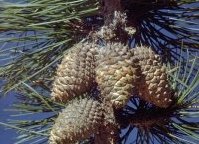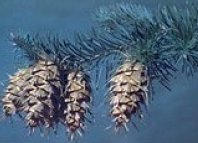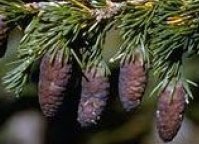Dichotomous keys were first used in 1778, and they remain the "industry standard" in reference books. At each step in a dichotomous key, there are 2 contrasting choices, no more and no less. Each choice in the series determines the next possible options.
Can you identify these North American trees? How does a larch tree differ from a pine tree?
1. Leaves are in bundles of 2 or more.
2. Bundles have 10 to 60 leaves; plants are deciduous; scales of seed cone have without a protrusion...... Larch (Larix)
2. Bundles have 2 to 5 leaves; plants are evergreen; scales of seed cone have a prickle or protrusionat tip ...... Pine (Pinus)
1. Leaves are solitary.
3. Leaves attach directly to stem; stem has smooth, round scars after leaves fall.4. Seed cones sit upright; cone scales without prominent lobes ...... Fir (Abies)3. Leaves attach to peglike projections on stem; stem has stubby pegs after leaves fall.
4. Seed cones hang down; cone scales with 3 lobes ...... Douglas-fir (Pseudotsuga)5. Leaves are flattened or four-sided and usually have a sharply pointed tip ...... Spruce (Picea)
5. Leaves are flattened and have a rounded or notched tip ...... Hemlock (Tsuga)
You can now identify these genera!
There are 38 pine tree species in North America. How can you tell them apart?
Try these tips for using an identification key
- Look up unfamiliar words in a glossary. Botanists may use a technical term to say something simple; for example, undulate means wavy. Expand your vocabulary and impress your peers.
- Read all the options before deciding which leads to follow.
- Examine more than one sample of the unknown plant. This allows you to observe how individuals within a species vary. For example, petals may range from white to pink. Leaves may have 3 or 4 lobes. Some plant samples may be incomplete, missing a critical leaf, flower, or fruit.
- Examine a plant with flowers or fruits if possible. These may be necessary for a correct identification.
- Use a ruler to determine the length and width of plant parts. Species differ in leaf, flower, or fruit size.
- Use a hand lens to examine small details such as hairiness.
- Take careful notes about your mystery species and its environment. Compare your notes to leads in the key and descriptions in a field guide.
Now write your own identification key
Writing a key is easiest when you can closely examine live specimens. Plants offer many opportunities to design keys. Base an identification key on different types of fruits or leaves or twigs. If your class prepared plant specimens, you can design a key using a variety of characteristics, just like a professional botanist.
Materials for Designing a Key
| —
6 or more different types of plants, at least 2
samples of each type |
— Ruler |
| — Pencil and paper | — Hand lens |
| — Field guide for your region (optional) |
Steps to Designing a Dichotomous Key
Make preliminary observations Look closely at your plant samples. What patterns do you see? Do they differ in the number of petals, number of leaf veins, arrangement of leaves along the stem? Sort the samples into like kinds. How do they differ in shape, color, size, texture?Get down to business Work in teams of two. Consult with your partner to decide the characteristics you will use to identify the different plants. Write a dichotomous key, continue dividing groups using the selected characteristics until each type of plant is sorted and named (use a common name if you don't know the plant species). Each team member could be responsible for one lead per couplet, or team members could take turns writing couplets. Finished? Now, try using the key to identify each plant type, revise your key as needed.
Test it Trade materials with another team. First examine the new samples. Then use the key to identify each plant type. How could the team improve its key? Are their other ways of grouping the specimens, of ordering the options? Swap materials and lists of suggested improvements.
Refine it Take into consideration the suggestions you received. Refine your key.
- New tricks of the trade Interactive, multi-access keys are increasingly common online. Multi-access keys differ from dichotomous keys because they allow you to consider the options in any order. That is helpful if a specimen lacks an important part, making it impossible to decide between particular options. Although fun and easy to use, multi-access keys are time-consuming to write.
If you have access to the web, take a look at these websites:
Photo answers: (a) = Larch; (b) = Pine; (c) = Fir; (d) = Douglas-fir; (e) = Spruce; (f) = Hemlock





